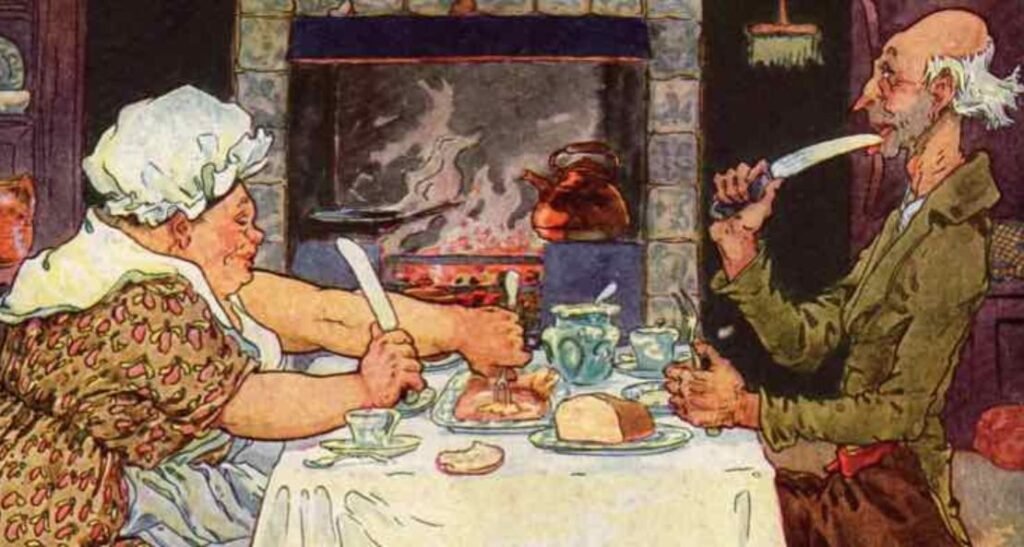The Enduring Appeal of Nursery Rhymes
From generation to generation, nursery rhymes have woven a tapestry of delight and wisdom, captivating the hearts and minds of young and old alike.
These seemingly simple verses, passed down through the ages, hold a profound depth of meaning, often serving as metaphors for life’s profound truths.
One such timeless gem is the nursery rhyme “Jack Sprat,” a delightful ditty that has endured the test of time, resonating with audiences across cultures and eras.
A Harmonious Union: The Essence of “Jack Sprat”
At its core, the rhyme “Jack Sprat” celebrates the beauty of a harmonious union, where two individuals, though different, complement each other perfectly.
The four whimsical lines paint a vivid picture:
Jack Sprat could eat no fat, His wife could eat no lean. And so between them both, you see, They licked the platter clean.
This simple yet profound verse encapsulates the essence of a successful partnership, where each partner’s strengths and preferences balance the other’s, creating a harmonious whole.
The rhyme’s enduring popularity lies in its ability to convey a universal truth about relationships in a concise and memorable manner.
The Origins: Tracing the Roots of a Beloved Rhyme
The origins of “Jack Sprat” can be traced back to the 16th century, when the name “Jack Sprat” was a colloquial term used to refer to individuals of diminutive stature.
However, the rhyme itself first appeared in print in John Clarke’s collection of sayings in 1639, where it was recorded as:
Jack will eat not fat, and Jull doth love no leane. Yet betwixt them both they lick the dishes cleane.
This early version showcases the rhyme’s evolution over time, retaining its core message while adapting to the linguistic nuances of each era.
Interpretations and Theories: Unravelling the Layers of Meaning
Like many nursery rhymes, “Jack Sprat” has been the subject of various interpretations and theories, each offering a unique perspective on its underlying meaning.
One popular theory suggests that the rhyme was a veiled satire on King Charles I and his wife, Henrietta Maria.
According to this interpretation, the “lean” Charles was left without resources when Parliament denied him taxation, but upon dissolving Parliament, he and his queen were able to “lick the platter clean.”
While this theory adds an intriguing historical layer to the rhyme, its enduring appeal transcends any specific historical context.
“Jack Sprat” has become a timeless metaphor for the power of complementary partnerships, resonating with audiences across generations and cultures.
Opposites Attract: The Science Behind the Adage
The notion of opposites attracting is not merely a romantic notion; it finds support in scientific principles as well.
Diversity plays a crucial role in ensuring the robustness and resilience of any system, be it biological, social, or cultural.
By embracing differences, individuals and communities can tap into a broader range of perspectives, skills, and resources, fostering growth and adaptability.
In the context of relationships, this principle holds true. Partners who possess complementary traits and strengths can navigate life’s challenges more effectively by leveraging each other’s unique qualities.
This synergy not only enriches the relationship but also contributes to personal growth and fulfilment for both individuals.
Nurturing Harmony: Lessons from “Jack Sprat” for Lasting Partnerships
While “Jack Sprat” may seem like a lighthearted nursery rhyme, it imparts valuable lessons for nurturing lasting partnerships. Here are some key takeaways:
- Embrace Differences: Recognise and appreciate the unique strengths and preferences of your partner, rather than attempting to change or diminish them.
- Cultivate Complementarity: Identify areas where your partner’s strengths complement your weaknesses, and vice versa. Leverage this complementarity to create a harmonious whole.
- Practice Mutual Respect: Respect and value each other’s contributions, perspectives, and roles within the partnership.
- Foster Open Communication: Maintain open and honest communication to navigate differences and find mutually satisfying solutions.
- Celebrate Individuality: While embracing your differences, also celebrate and nurture each other’s individuality, allowing for personal growth and fulfilment within the partnership.
By embodying these principles, couples can create a harmonious and enduring union, much like Jack Sprat and his wife, who “licked the platter clean” together.
The Enduring Legacy: “Jack Sprat” in Popular Culture
The enduring popularity of “Jack Sprat” is evident in its permeation throughout various facets of popular culture.
From literature to film and television, the rhyme has been referenced, reimagined, and celebrated in countless ways.
In literature, authors have drawn inspiration from the rhyme’s themes of complementarity and harmony.
Jasper Fforde’s “Jack Spratt” series, for instance, features a fictional detective named Jack Spratt, whose unique abilities and quirks complement those of his partner, Mary Mary.
On the silver screen, the rhyme has been incorporated into various children’s films and television shows, often serving as a playful nod to its timeless appeal or as a means of imparting valuable lessons about cooperation and teamwork.
The Universality of “Jack Sprat”: Transcending Boundaries
Despite its humble origins as a nursery rhyme, “Jack Sprat” has transcended cultural and linguistic boundaries, resonating with audiences worldwide.
Translations and adaptations of the rhyme can be found in numerous languages, each capturing the essence of the original while infusing it with local cultural nuances.
This universal appeal is a testament to the rhyme’s ability to convey a fundamental truth about human relationships: the power of complementarity and the beauty that arises when individuals with different strengths and preferences come together in harmony.
Passing the Torch: Keeping the Tradition Alive
As generations pass, the responsibility of preserving and passing down the rich tapestry of nursery rhymes falls upon parents, educators, and storytellers.
“Jack Sprat” serves as a reminder of the importance of keeping these timeless gems alive, not only for their entertainment value but also for the invaluable life lessons they impart.
By sharing “Jack Sprat” with children, we instill in them the values of cooperation, mutual respect, and the celebration of diversity.
These lessons, woven into the fabric of the rhyme, have the power to shape young minds and foster a more harmonious and inclusive society.
Conclusion: A Timeless Celebration of Marital Bliss
In the grand tapestry of nursery rhymes, “Jack Sprat” stands as a timeless celebration of marital bliss, a testament to the power of complementarity and the beauty that arises when differences are embraced.
From its humble beginnings in the 16th century to its enduring presence in popular culture, this delightful ditty has captured the hearts and imaginations of audiences across generations and cultures.
As we continue to pass down this cherished rhyme, may it serve as a reminder of the richness that lies in embracing our differences and working together in harmony, much like Jack Sprat and his wife, who “licked the platter clean” through their complementary strengths and preferences.
You might also like:
- 1 2 Buckle My Shoe: Exploring the Viral TikTok Trend
- Gracie’s Corner: The YouTube Galaxy Where Kids’ Dreams and Learning Collide
- Olive Louise’s ‘Bad Things’ Spins A Dark Tale
- It’s Raining, It’s Pouring Meaning Unveiled: Decoding the Ominous Undertones of the Nursery Rhyme
Lyrics Of Jack Sprat In English
Here are the lyrics of the famous Jack Sprat poem for kids.
Jack Sprat could eat no fat.
His wife could eat no lean.
And so between them both, you see,
They licked the platter clean.
Jack ate all the lean,
Joan ate all the fat.
The bone they picked it clean,
Then gave it to the cat.


